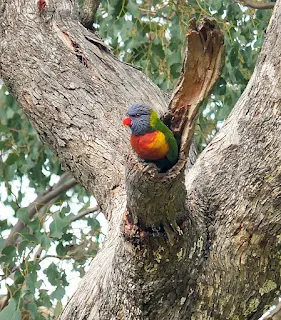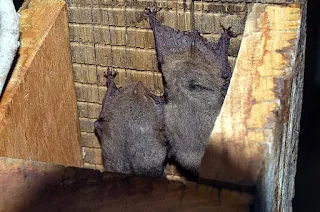Many native birds, mammals and reptiles use tree hollows for
roosting and breeding.
If they live long enough, most eucalypts will develop
hollows through natural processes of weathering, decay and fire. Many
introduced trees do not readily form hollows.
This giant Mountain Grey Gum on the corner of Settlement Rd and Springwater Dr is like a skyscraper of diversity. (click on images for a larger view)
The decline in indigenous faunal species in an ecosystem can often be directly proportional to the loss of tree hollows – land clearing for urbanization, infrastructure, agriculture, etc.
Hollows of all sizes and shapes are used by a huge variety of species.
For many years now, environmentalists have declared that part of the answer to this decline in our native birds and mammals in particular is to erect artificial nest boxes. Many references exist for the design and advice for erecting nest boxes.
About one third of Australia's birds need hollows for nesting - Rainbow Lorikeet.
However, recently there has been research conducted that concludes that erecting nest boxes does little for the conservation of native species and in fact can create further problems.
# Nest boxes do not
sequester carbon.
Well of course they don’t and they’re not meant to.
Obviously, we should be planting more trees to do this. Perhaps in the mean
time a few nest boxes might help the survival of the odd native bird, mammal or
reptile.
Eastern Rosellas will readily take to an artificial nest box.
# Nest boxes don’t
last long and are often destroyed by their inhabitants or the weather.
Of course – they are ‘artificial’ and will require periodic
repair or replacement. The chewing of a nest box at least indicates it’s being
used surely?
Just a few weeks after being erected in Binbeal Rd, this nest box showed very clear evidence of being occupied.
# Nest boxes attract
feral species.
And natural tree hollows don’t? A short walk into a patch of
bush is all that’s needed to observe feral bees, Common Mynas, Starlings, etc
using tree hollows.
# Tree hollows
provide insulation for their inhabitants that nest boxes do not.
Perhaps, but it does depend a bit on the material used in
the construction of a box and where you locate it – in the shade for example.
Anecdotally, it requires rather extreme temperatures to affect the animals
inside a well-built nest box. Also anecdotally, many native animals use tree
hollows that are poorly orientated or are far too small for their purpose
consequently exposing their inhabitants to the elements.
Micro-bats in a purpose built box under the verandah of a house.
One researcher has quoted that the difference between a nest
box and a chain-saw hollow is analogous to the difference between a demountable
house and a grand old home with thick insulating walls. Surely a demountable is
preferable if a grand old home is not available to everyone?
Ringtail Possums will adapt to a 'parrot nest box' very readily. Ringtails often have 2 or 3 dreys or hollows within their range.
Yes, let’s stop chopping down our large, hollow-bearing
trees.
Yes, let’s start seriously replacing any lost/removed old
trees with similar species that given enough time – probably 150+ years – will
provide some natural hollows for our native fauna.
Yes, let’s explore the technique of carving tree hollows
with a chain saw.
And yes – let’s in the meantime provide some
well-constructed, sensibly-oriented and monitored nest boxes that might mean
the survival of a species!







Great article.Looking forward to 2019 and setting up some boxes.
ReplyDelete